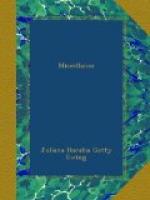Many of her own innumerable hobbies had such origins, I know. The influence of German literature on some of her writings is very obvious, and this most favourite study sprang chiefly from a very early fit of hero-worship for Elizabeth Smith, whose precocious and unusual acquirements she was stirred to emulate, and whose enthusiasm for Klopstock she caught. The fly-leaf of her copy of the Smith Remains bears (in her handwriting) the date 1820, with her name as Meta Scott; a form of her own Christian name which she probably adopted in honour of Margaretta—or Meta—Klopstock, and by which she was well known to friends of her youth.
She often told us, too, of the origin of another of her accomplishments. She was an exquisite caligraphist. Not only did she write the most beautiful and legible of handwritings, but, long before illuminating was “fashionable,” she illuminated on vellum; not by filling up printed texts or copying ornamental letters from handbooks of the art, but in valiant emulation of ancient MSS.; designing her own initial letters, with all varieties of characters, with “strawberry” borders, and gold raised and burnished as in the old models. I do not know when she first saw specimens of the old illuminations, for which she had always the deepest admiration, but it was in a Dante fever that she had resolved to write beautifully, because fine penmanship had been among the accomplishments of the great Italian poet. How well she succeeded her friends and her printers knew to their comfort! To Dante she dedicated some of her best efforts in this art. In 1826, when she was seventeen, she began to translate the Inferno into English verse. She made fair copies of each canto in exquisite writing, and dedicated them to various friends on covers which she illuminated. The most highly-finished was that dedicated to an old friend, Lord Tyrconnel, and the only plain one was the one dedicated to another friend, Sir Thomas Lawrence. The dedication was written in fine long characters, but there was no painting on the cover of the canto dedicated to the painter.
I do not know at what date my mother began to etch on copper. It was a very favourite pursuit through many years of her life, both before and after her marriage. She never sketched much in colour, but her pencil-drawings are amongst the most valuable legacies she has left us. Trees were her favourite subjects. One of her most beautiful drawings in my possession is of a tree, marked to fall, beneath which she wrote:
“Das ist das Loos des Schoenen auf der Erde."[2]
Of another talent nothing now remains to us but her old music-books and memories of long evenings when she played Weber and Mozart.




